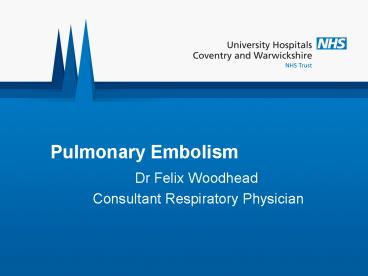Pulmonary Embolism - PowerPoint PPT Presentation
1 / 20
Title:
Pulmonary Embolism
Description:
Pulmonary Embolism Dr Felix Woodhead Consultant Respiratory Physician Pulmonary Embolism Part of VTE Potentially fatal Can complicate hospital admission Preventable ... – PowerPoint PPT presentation
Number of Views:595
Avg rating:3.0/5.0
Title: Pulmonary Embolism
1
Pulmonary Embolism
- Dr Felix Woodhead
- Consultant Respiratory Physician
2
Pulmonary Embolism
- Part of VTE
- Potentially fatal
- Can complicate hospital admission
- Preventable
- Tests poor
3
Risk factors
- Surgery
- Abdominal
- Lower limb
- Obstetric
- Malignancy
- Previous VTE
4
Clinical Probability
- Wells score
- Geneva criteria
- Is a major risk factor present? 1
- Is there no other explanation? 1
- Score
- 2 High probability
- 1 Intermediate probability
- 0 Low probability
5
D-dimer
- Only useful if NEGATIVE
- ? by many things (including pregnancy and
infection) - Used only after assessment of clinical
probability - Not used if high clinical probability
6
Imaging
- CTPA in most places
- V/Q
- only if normal CXR and no cardiopulmonary disease
- Intermediate scan requires follow-up imaging
(CTPA) - Doppler USS if DVT (no need for resp imaging)
7
Screening for thrombophilia/cancer
- Thrombophilic abnormality occurs in 25-50 VTE
- Usually interacts with environment (esp
oestrogens), and risk is multiplicative - Does not predict risk of recurrence
- Screen for cancer with bloods, clinical picture
and CXR only
8
Treatment
- Thrombolysis only in massive PE (circ collapse)
- Thrombolysis controversial if RV impairment
- Anticoagulate with LMWH then warfarin for
- 4-6/52 if associated with temporary risk factor
- 3/12 if no risk factor (BTS), US recommend 6/12
- ?unfractionated heparin initial bolus
9
Pulmonary Arterial Hypertension
- Dr Felix Woodhead
- Consultant Respiratory Physician
10
Findings
- Exertional breathlessness
- Exertional chest pain and presyncope
- Normal radiology if idiopathic
- Normal PFTs if idiopathic
- ? systolic PAP on echo only if TR
11
Defined by RHC
- mPAP
- gt 25 mmHg at rest (normal 12-16 mmHg)
- gt 30 mmHg on exertion
- Cardiac Output
- Cardiac Index (CO/height2)
- Pulmonary Vascular Resistance
12
Causes
- Left ventricular impairment (PCWP gt 15)
- LVF
- Mitral valve disease
- Increased pulmonary blood flow (L?R shunt) ?
Eisenmengers syndrome - Hypoxaemia (cor pulmonale)
- Chronic Thromboembolic (CTEPH)
- HIV
- CTD (SSc etc)
- Idiopathic (IPAH)
13
Investigations
- PFTs
- CTPA
- Echo ( bubbles)
- 6 minute walk
- Right Heart Catheter
- (traditional) pulmonary angiogram
14
Treatment
- Treatment of associated causes
- LV disease
- O2 for cor pulmonale
- Warfarin (for all)
- Calcium channel blockers little used now
- Endothelin receptor blockers Bosentan,
sitaxentan - PDE4 antagonists Sildenafil etc
- Prostaglandins
- Nebulised
- Continuous IV via Hickman line
15
Sleep medicine
- Dr Felix Woodhead
- Consultant Respiratory Physician
16
Obstructive sleep apnoea/hypopnoea Sx
- Periodic reduction of airflow at night
- Caused by ostruction (cf central apnoea) due to
reduced muscle tone in a suceptible airway
(obesity) - Apnoea no airflow for 10 s
- Hypopnoea 50 airflow in 10 s
- AHI (apnoea/hypopnoea index) no of events/hr
- AHI
- 5-14 mild
- 15-30 moderate
- gt30 severe
17
Symptoms
- Sleepiness (daytime hypersomnolence)
- Epworth Sleepiness Score
- Witnessed apnoeas
- Nocturia
- Hypertension
- Reduced concentration
- Reduced libido
- Tendency to cor pulmonale, esp in COPD
18
Diagnosis
- Overnight oximetry
- Good screening esp in obese
- Cannot be used to exclude OSAHS
- Limited PSG
- Useful initial test in young, non-obese
- Full PSG
19
Treatment
- Only if symptomatic
- AHI gt15, desat index gt10/hr
- Nasal CPAP
- fixed
- Autotitrating device
20
Domiciliary NIV
- For ventilatory failure
- Other treatments
- Low flow O2 (with care)
- Treatment of sleep disordered breathing
- Hallmark of ventilatory failure is ?pCO2

